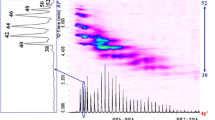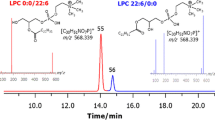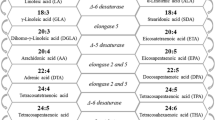Abstract
The chromatographic behavior of molecular species of free fatty acids, triglycerides, sterol esters and wax esters on Chromarods-SII was investigated in four developing solvent systems of different polarities. In accordance with previous reports it was observed that molecular species within a lipid class are partially separated according to the chain length and degree of unsaturation of the acyl groups. The separation is more affected by the degree of unsaturation than the chain length, especially in nonpolar solvent systems. In polar solvent systems the separation within a lipid class is less efficient; a slight separation according to the chain length was observed, and the degree of unsaturation had little or no influence. The partial separation of molecular species within a class leads to the superimposing of certain lipid classes, for example glyceryl ethers and highly unsaturated fatty acids of marine origin. This poses a potential problem in identification of Iatroscan peaks. However, with totally hydrogenated marine lipid samples a complete separation of the lipid classes was achieved when developed in a nonpolar solvent system. It is proposed that at least two kinds of authentic standards varying in the degree of unsaturation and chain length should be used for the identification of the peaks of natural lipid samples of unknown composition, and that total hydrogenation be applied to improve separations and ensure sample stability, and probably to improve quantitation accuracy.
Similar content being viewed by others
References
Christie, W.W., and M.L. Hunter,J. Chromatogr. 171:517 (1979).
Innis, S.M., and M.T. Clandinin, Ibid. 490 (1981).
Harvey, H.R., and J.S. Patton,Anal. Biochem. 116:312 (1981).
Foot, M., and M.T. Clandinin,J. Chromatogr. 241:428 (1982).
Peterson, B., Ibid.:313 (1982).
Ranny, M., M. Zbirousky, M. Blahova, V. Ruzikka and S. Truchlik, Ibid.:327 (1982).
Kaitaranta, J.K.,J. Food Technol. 17:87 (1982).
Hiramatsu, K., and S. Arimori,J. Chromatogr. 227:423 (1982).
Parrish, C.C., and R.G. Ackman, Ibid.:103 (1983).
Kaneko, H.,Yukagaku 32:565 (1983).
Delmas, R.P., C.C. Parrish and R.G. Ackman,Anal. Chem. 56:1272 (1984).
Parrish, C.C., and R.G. Ackman,Lipids 20:521 (1985).
Ratnayake, W.M.N., and R.G. Ackman,Can. Inst. Food Sci. Technol. J. 18:284 (1985).
Volkman, J.K., D.A. Everitt and D.I. Allen,J. Chromatogr. 356:147 (1986).
Fraser, A.J., D.R. Tocher and J.R. Sargent,J. Exp. Mar. Biol. Ecol. 88:91 (1985).
Bligh, E.G., and M.A. Scott,J. Fish. Res. Bd. Canada 23:1025 (1966).
Addison, R.F., R.G. Ackman and J. Hingley, Ibid.:2083 (1968).
Ratnayake, W.M.N., A. Timmins, T. Ohshima and R.G. Ackman,Lipids 21:518 (1986).
Kramer, J.K.G., R.C. Fouchard and E.R. Farnworth, Ibid.:617 (1985).
Kramer, J.K.G., R.C. Fouchard and E.R. Farnworth,J. Chromatogr. 198:279 (1980).
Ackman, R.G., inMethods in Enzymology, Vol. 72, Lipids part D, edited by J.M. Lowenstein, Academic Press, New York, NY, 1981, pp. 205–252.
Phillips, F., and C.V. Viswanathan,Lipids 2:437 (1967).
Bligh, E.G., and W.J. Dyer,Can. J. Biochem. Physiol 37:911 (1959).
Galanos, D.S., and V.M. Kapoulas,J. Lipid Res. 3:134 (1962).
Snyder, L.R., inPrinciples of Adsorption Chromatography, Marcel Dekker, Inc., New York, NY, 1968, pp. 185–240.
Sipos, J.C., and R.G. Ackman,J. Chromatogr. Sci. 16:443 (1978).
Ackman, R.G., C.A. Eaton and C. Litchfield,Lipids 6:69 (1971).
Kayama, M., Y. Tsuchiya and J.C. Nevenzel,Bull. Jpn. Soc. Sci. Fish 37:111 (1971).
Hayashi, K., and T. Takagi, Ibid.:281 (1981).
Body, D.R.,J. Sci. Food Agric. 36:679 (1985).
Kramer, J.K.G., B.K. Thompson and E.R. Farnworth,J. Chromatogr. 355:221 (1986).
Author information
Authors and Affiliations
About this article
Cite this article
Ohshima, T., Ratnayake, W.M.N. & Ackman, R.G. Cod lipids, solvent systems and the effect of fatty acid chain length and unsaturation on lipid class analysis by Iatroscan TLC-FID. J Am Oil Chem Soc 64, 219–223 (1987). https://doi.org/10.1007/BF02542005
Received:
Issue Date:
DOI: https://doi.org/10.1007/BF02542005




